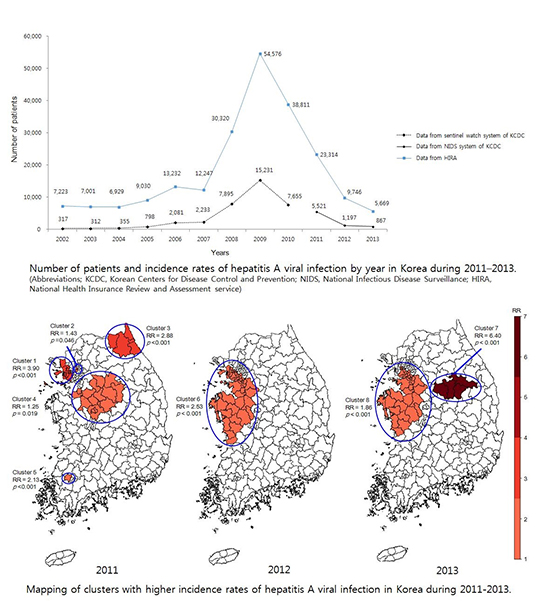1. Krugman S, Ward R, Giles JP, Bodansky O, Jacobs AM. Infectious hepatitis: detection of virus during the incubation period and in clinically inapparent infection. N Engl J Med. 1959; 261:729–734.
2. Lednar WM, Lemon SM, Kirkpatrick JW, Redfield RR, Fields ML, Kelley PW. Frequency of illness associated with epidemic hepatitis A virus infections in adults. Am J Epidemiol. 1985; 122:226–233.
3. Lee D, Cho YA, Park Y, Hwang JH, Kim JW, Kim NY, Lee DH, Lee W, Jeong SH. Hepatitis a in Korea: epidemiological shift and call for vaccine strategy. Intervirology. 2008; 51:70–74.
4. Gust ID. Epidemiological patterns of hepatitis A in different parts of the world. Vaccine. 1992; 10:Suppl 1. S56–S58.
5. Jenson HB. The changing picture of hepatitis A in the United States. Curr Opin Pediatr. 2004; 16:89–93.
6. Sohn YM, Rho HO, Park MS, Park JH, Choi BY, Ki M, Jang WI. The changing epidemiology of hepatitis A in children and the consideration of active immunization in Korea. Yonsei Med J. 2000; 41:34–39.
7. Song MH, Lim YS, Song TJ, Choi JM, Kim JI, Jun JB, Kim MY, Pyun DK, Lee HC, Jung YH, et al. The etiology of acute viral hepatitis for last 3 years. Korean J Med. 2005; 68:256–260.
8. Chung SJ, Kim TY, Kim SM, Roh M, Yu MY, Lee JH, Oh C, Lee EY, Lee S, Jeon YC, et al. Changes in the seroprevalence of IgG anti-hepatitis A virus between 2001 and 2013: experience at a single center in Korea. Clin Mol Hepatol. 2014; 20:162–167.
9. Kwon SY, Park SH, Yeon JE, Jeong SH, Kwon OS, Lee JW, Kim HS, Seo YS, Kim YS, Sohn JH, et al. Clinical characteristics and outcomes of acute hepatitis a in Korea: a nationwide multicenter study. J Korean Med Sci. 2014; 29:248–253.
10. Kim JH. Recent epidemiological status and vaccination of hepatitis A in Korea. J Korean Med Assoc. 2008; 51:110–118.
11. Barzaga BN. Hepatitis A shifting epidemiology in South-East Asia and China. Vaccine. 2000; 18:Suppl 1. S61–S64.
12. Hong WS, Kim JR. The epidemiologic study of seroprevalence of hepatitis A and B antibodies in Seoul. Korean J Intern Med. 1982; 25:19–26.
13. Lim DS, Cho KH, Kim HC. Seroepidemiological study of anti-HAV antibody in Cheon-Buk province in 1989. Korean J Intern Med. 1992; 43:57–65.
14. Cui F, Hadler SC, Zheng H, Wang F, Zhenhua W, Yuansheng H, Gong X, Chen Y, Liang X. Hepatitis A surveillance and vaccine use in China from 1990 through 2007. J Epidemiol. 2009; 19:189–195.
15. Bell BP, Shapiro CN, Alter MJ, Moyer LA, Judson FN, Mottram K, Fleenor M, Ryder PL, Margolis HS. The diverse patterns of hepatitis A epidemiology in the United States-implications for vaccination strategies. J Infect Dis. 1998; 178:1579–1584.
16. Tsou TP, Liu CC, Huang JJ, Tsai KJ, Chang HF. Change in hepatitis A epidemiology after vaccinating high risk children in Taiwan, 1995-2008. Vaccine. 2011; 29:2956–2961.
17. Chau TN, Lai ST, Lai JY, Yuen H. Acute viral hepatitis in Hong Kong: a study of recent incidences. Hong Kong Med J. 1997; 3:261–266.
18. Papaevangelou G, Roumeliotou-Karayannis A, Contoyannis P. Changing epidemiological characteristics of acute viral hepatitis in Greece. Infection. 1982; 10:1–4.
19. Francis DP, Hadler SC, Prendergast TJ, Peterson E, Ginsberg MM, Lookabaugh C, Holmes JR, Maynard JE. Occurrence of hepatitis A, B, and non-A/non-B in the United States. CDC sentinel county hepatitis study I. Am J Med. 1984; 76:69–74.










 PDF
PDF ePub
ePub Citation
Citation Print
Print



 XML Download
XML Download